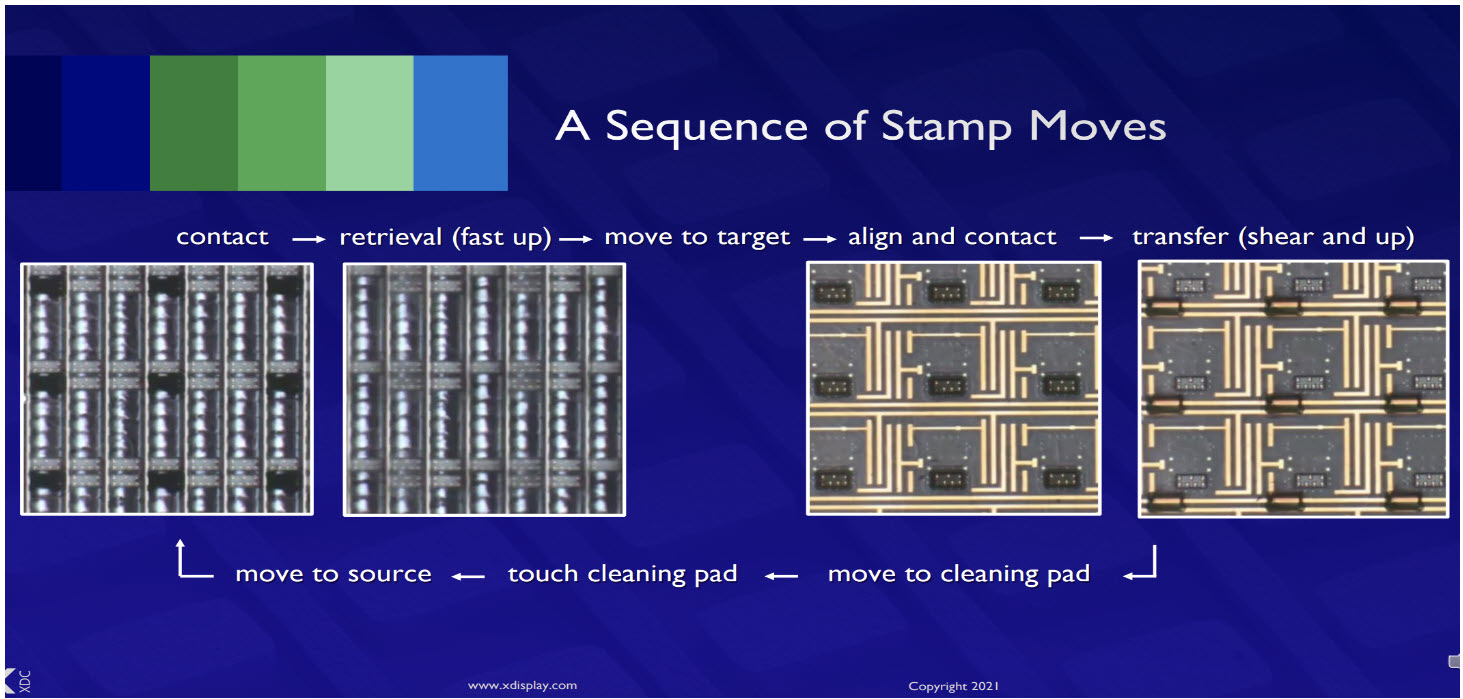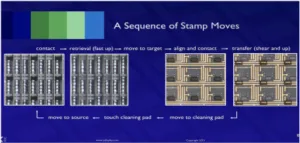In the first part of this article (MicroLED Display: Road to Commercialization Part 1, I covered investment, chip and LED manufacture and inspection repair and yield. Here, I’m covering mass transfer, supply chain development and the application market.

Mass transfer & Bonding
Mass transfer is critical for cost competitiveness with TFT-LCD and OLED.
- X Display Company (XDC) presented that mass transfer throughput and yield can be improved by using elastomer stamps. The company showed that for a 5.1″ display, by using their PixelEngine and microICs, they are able to achieve functional sub-pixel yield of: red100%, green 99.996% and blue 99.998%. By using PixelEngine devices (microIC, RGB, All-In-One) they are able to increase mass transfer throughput. The company said elastomer stamp mass transfer is scalable using a conformable stamp with tunable short-range adhesion forces that achieved 99.99% transfer yields in R&D.
- Recent news from Electronics and Telecommunications Research Institute (ETRI) Korea showed that a new material, SITRAB adhesive, can be used to combine the transfer and bonding process into one process (applied homogenized laser to the SITRAB film attached to the MicroLED for a few seconds to develop the core process of simultaneous transfer and bonding). ETRI said this technology can reduce the high investment costs for transfer and bonding equipment and can also help to perform repair of defective pixels.
- Coherent recently announced its new UVtransfer integrated laser system that performs three processes in MicroLED fabrication: Laser Lift-Off (LLO), laser-Induced Forward Transfer (LIFT), and repair/trimming.
- Vuereal presented its Micro-Solid printing technology that can overcome the limitation to throughput and yield challenges.
- A collaboration of PlayNitride, Unimicron Corp (PCB backplane), and Macroblock (driver ICs) have shown the use of mass transfer of MicroLED onto a printed circuit board backplane, which can reduce production costs.
- Compound Photonics has developed its IntelliPix end to end microdisplay platform for AR/MR. The company presented that it is well positioned to extend IntelliPix’s benefits and pixel array design expertise to direct view displays.
 Source; XDisplay Display Week 2021
Source; XDisplay Display Week 2021
Supply Chain Development
There are many different options and processes to resolve microLED manufacturing issues for commercialization. A supply chain ecosystem is proving difficult to develop for mass production because of the many underlying issues.
- There is no standard manufacturing solution for commercialization. Every firm has its own idea.
- Start-up companies are mostly fabless with licensing capabilities, and they need partnerships for manufacturing. Large established companies are reluctant to depend on a single start-up for their supply.
- Suppliers with LTPS-TFT capacity for backplane or other manufacturing capabilities need to invest capital for transfer, inspection/testing, and create a path to mass market.
- Panel suppliers and set suppliers need to be confident about profit margins for on-going business to allow them to invest capital.
More partnership and collaborations among panel makers, set makers and MicroLED chipmakers are required. Major display suppliers – Samsung, LGD, AUO, Innolux, BOE, Tianma, CEC Panda, Visionox and others are all increasing their activities in microLED display, which will help to establish supply chains for volume production.
Application Market
There are already many microLED demonstrations in different applications, such as large-size TV, automotive transparent display, flexible display, wearable devices and as AR/HUD display source.
- PlayNitride: has developed a selective mass addressable repair technology for lower cost. The company showed a 1.39″ circular display for wearables and a 7.56″ transparent display for photoframes as well as an 89″ 5K ultra wide curved displays at DisplayWeek 2021.
- Royole: A microLED with ultra low aperture ratio and simple or non-encapsulation requirements, can lead to high stretchability, fine pitch and high transmittance. Using 90x 150 micron LEDs, a 2.7″ 42 PPI RGB stretchable microLED panel was also demonstrated.
- Vuereal: its Micro-Solid Printing Technology has allowed the development of custom displays for niche markets such as high-brightness, high-transparency (>80%) display, wearable, and automotive. Samples will be available in Q4 2021.
- Jade Bird Display: announced the mass product of 0.13″ monochrome microLED microdisplay panels and optical engines and assemblies. These products enable ultra-compact AR glass designs.
- AUO: received the best technology demonstration award at DisplayWeek for its integrated vehicle cockpit with microLED display after showing a 12″ auto display, a 10.4″ transparent display and a 1.4″ round MicroLED display panel.
Companies are initially targeting digital signage, public display, AR/VR, wearable, and automotive (HUD) applications.
In Conclusion
High-speed transfer, assembly technologies, yield and defect management need to improve and supply chains need to be established before large volume commercialization in consumer products can be done. In the meantime, suppliers will focus on markets with higher priced, lower volume, value-based products. (SD)
Publisher’s Note (the two parts of this article will be counted as a single one for the purposes of your free article allowance)
Sweta Dash is the founding president of Dash-Insights, a market research and consulting company specializing in the display industry. For more information, contact [email protected] or visit www.dash-insight.com

